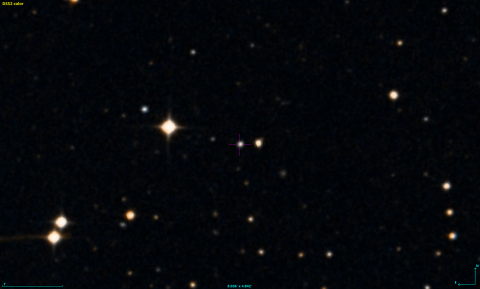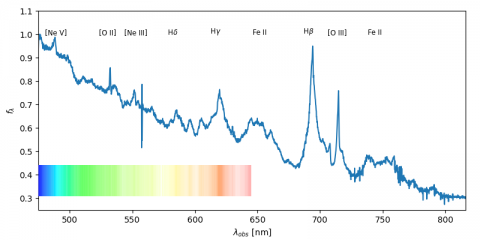The history of the quasar HE 0435-5304 – the distance matters!
03-03-2022
Publicly available data is not too popular among scientific breakthrough seekers. Usually they were extensively researched and there is nothing more to discover. However, there are exceptions, such as the quasar HE 0435-5304, which sounds boring by name.
Determining the distance to cosmic objects allows us to estimate how much energy they produce and what processes are responsible for their glow. This is especially interesting when an object appears to be an extreme case in the population. The quasar HE 0435-5304 is unique in many ways due to its high luminosity and above-average activity.
An interesting object with quite a boring name HE 0435-5304 was taken under scrutiny by scientists from the National Centre for Nuclear Research (NCNR) and Astronomical Observatory of the Jagiellonian University (JU). It is a quasar*, visible in the southern sky in close proximity to the southern ecliptic pole. As an area far from the galactic disk it is not as obscured with dust and has a lower number of stars. Because of that it is one of the best „windows” to distant Universe outside our Galaxy. Therefore, based on observations by the Japanese satellite AKARI, a survey called Akari Deep Field-South (ADF-S) has been performed there, identifying a number of galaxy candidates for Luminous and Ultra Luminous Infrared Galaxies (LIRG/ULIRG**).
Quasar HE 0435-5304 has caused many problems in its analysis from the beginning. According to earlier spectroscopic measurements, the results of which can be found in publicly available catalogues and scientific papers, it was supposed to be distant from us by 8.7 billion light years. Meanwhile, already the first estimates of the Polish team indicated that a much smaller distance – about 3.5 billion light years – was much more likely. These estimates, however, were based on photometric measurements, which are assumingly less accurate than spectroscopic measurements.***
Measuring the physical properties of a quasar and its parent galaxy requires knowledge of its distance. Assuming a distance of 8.7 billion light-years, HE 0435-5304 appeared to be a very unusual object, with extremely high star formation rate, even in the category of galaxies undergoing a burst of star-forming activity. The standard physical analysis results obtained indicated the completely exotic, monstrous nature of this quasar, forming huge numbers of new stars.
However, it turned out that another research team, based on the ultraviolet spectrum, estimated the distance to HE 0435-5304 at 4.3 billion light years, which is also significantly below the catalogue value. Researchers from NCNR and JU decided to finally solve the problem of the distance to the quasar HE 0435-5304. They performed observations with the Southern African Large Telescope (SALT), in which Poland has a 10% financial share, and therefore also observing time. Based on their own observations, they measured the optical spectrum of the quasar. In their research they also used data from ESO’s Very Large Telescope (VLT).
It turned out that quasar HE 0435-5304 is 4.5 billion light years away from us – almost twice as close as previous measurements published 20 years ago suggest. Further analysis has revealed that at the centre of the object is a supermassive black hole with a mass of 117 million solar masses, and that strong (although not as extreme as previously thought) star-forming processes are taking place in its parent galaxy. The galaxy is heavily dusty, but the dust obscures the stars but does not cover the nucleus itself – the quasar. HE 0435-5304 is most likely in the process of merging with another galaxy, which could both initiate new star formation and stimulate quasar activity. The quasar itself belongs to the rare Extreme Type A population.
„Our analysis of the high-quality spectra shows that HE 0435-5304 is an extreme object of population A.” – says Dr Krzysztof Hryniewicz from the NCNR Astrophysics Facility – „Population A are those active galactic nuclei in which massive black holes accretes matter faster than the rest of the population. They are bright objects that are successfully used in studies of the distant Universe. In particular, the outermost group in this classification is the NLSy1 (Narrow Line Seyfert 1) group, with the narrowest emission lines. The activity of active galaxies is also indicated by the emission spectrum of iron, especially in the optical range. Based on the very strong iron ion emission we classified HE 0435-5304 into group xA, i.e., objects with extreme galactic nucleus activity and due to narrow lines close to NLSy1 objects. It is interesting to note that the intensity of these processes and the position of the quasar itself in the population changes noticeably with time. Unfortunately, the precision with which we could measure this effect is limited by the influence of the Earth’s atmosphere. We believe that this variability is related to a gradual decrease in the luminosity of the object. Additionally, the hydrogen emission lines have more complex shapes than in other active galactic nuclei with similar activity levels in the A population.”
„This is an exciting result given that HE 0435-5304 is very bright in the infrared wavelength range (it is an ULIRG), and is perhaps in the process of rapid mass growth in the merger of two galaxies.” – adds Małgorzata Bankowicz, a PhD student from the Astronomical Observatory of the Jagiellonian University who studies the properties of ULIRGs – „It is therefore very likely that the very rapid changes that are occurring in it (compared to the lifetimes of active galaxies) are due precisely to the unique evolutionary stage of the entire galaxy. Despite the clues provided by our analysis, it is still an open question whether there is a double black hole at the heart of HE 0435–5304 – even before merging in a galactic merger.’’
The research of the NCNR and JU teams confirms an old scientific principle – repeatability of measurements guarantees their reliability. And they show that even a seemingly well studied object may turn out to be a surprise quasar.
Source text: https://ui.adsabs.harvard.edu/abs/2022arXiv220104685H/abstract (Article soon to be published in Astronomy & Astrophysics)
Related articles:
https://ui.adsabs.harvard.edu/abs/2017A%26A...598A...1M/abstract
https://ui.adsabs.harvard.edu/abs/2010A%26A...514A..11M/abstract
Research carried out under funding obtained from the National Science Centre (UMO-2018/30/M/ST9/00757, UMO-2016/23/N/ST9/01231, UMO-2018/30/E/ST9/00082).
Data from the SALT telescope were acquired as part of the Polish contribution funded by the Ministry of Science and Higher Education (DIR/WK/2018/12).
Additional information:
*Quasars are distant active galactic nuclei of immense brightness. Their brightness is so great that their parent galaxies are not visible and look like stars. However, they are distinguished from stars by their distance from us and by their spectrum, which, unlike the absorption spectrum of stars, is emissive. This property is also why quasars are used to study the intergalactic medium, among other things.
** Luminous Infrared Galaxies (LIRGs) and Ultra Luminous Infrared Galaxies (ULIRGs) are rare and not well studied galaxy types. They are characterised by high bolometric luminosity in the infrared part of the electromagnetic spectrum and low luminosity in the optical part. The total infrared luminosity of LIRG-type galaxies is in the range of 1011–1012 solar luminosity, while that of ULIRG-type is 1012–1013 solar luminosity.
*** Depending on the scale of distances in the Universe, different methods of distance measurement are used in astrophysics, and the greater the distance, the more difficult it is to measure and the greater the uncertainty. In the case of the most distant objects, the concept of redshift is used. The redshift is defined as the ratio of the observed wavelength of light to the (presumed) wavelength emitted by the object, minus one, and indicates a significant distance in the Universe. Two methods are distinguished in redshift measurements: spectroscopic and photometric. The spectroscopic method of determining redshift, based on emission or absorption lines of elements identified in the spectrum of an object, is unquestionably considered by astronomers and astrophysicists to be the most accurate. The photometric method, on the other hand, based on model fitting of the spectrum to brightness „peaks” on given lengths of photometric filters, is statistically good, but much less accurate than the spectroscopic method, used only to estimate this value. It is therefore quite well suited for a global approach on whole catalogues.






